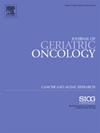拉丁美洲老年人弥漫性大b细胞淋巴瘤的临床特征、治疗模式和结局的真实世界数据:来自拉丁美洲研究小组(GELL)的一项研究
IF 3
3区 医学
Q3 GERIATRICS & GERONTOLOGY
引用次数: 0
摘要
弥漫性大b细胞淋巴瘤(DLBCL)是最常见的b细胞淋巴瘤类型,主要见于老年人。值得注意的是,关于拉丁美洲老年人DLBCL的数据仍然缺乏。材料与方法我们对608例年龄≥65岁的拉丁美洲新诊断的DLBCL患者进行回顾性分析。结果诊断时中位年龄为74岁(范围:65 - 96岁),女性占51%,东方肿瘤合作组(ECOG)表现状态(PS)≥2的占36%,疾病晚期占65%。最常用的方案是标准剂量R-CHOP (n = 420, 69%)、R-CVP (n = 77, 12%)、R-mini-CHOP (n = 74, 12%)和CHOP/CVP (n = 30, 5%)。中位随访60个月(95%可信区间[CI]: 38.7-75.2个月),5年总生存率(OS)为50% (95% CI, 43-58)。ECOG PS≥2(风险比[HR] 1.93;95% ci 1.51-2.46;p & lt;0.01)、临床晚期(HR 1.46;95% ci 1.12-1.91;p & lt;0.01),血清乳酸脱氢酶水平升高(HR 1.48;95% ci 1.16-1.87;p & lt;0.01),白蛋白水平<;3.5 mg/dL (HR 1.64;95% ci 1.29-2.10;p & lt;0.01)与较差的OS相关。使用蒽环类药物(HR 0.50;95% ci 0.38-0.66;p & lt;0.01)和使用利妥昔单抗(HR 0.51;95% ci 0.36-0.73;p & lt;0.01)与较好的OS独立相关。在拉丁美洲老年DLBCL患者的大型队列中,治疗和结果模式与国际上报道的相似。拉丁美洲缺乏标准化的老年病学评估,这是一个重要的研究领域,可以更好地对被认为具有较高毒性风险的DLBCL老年患者进行分层。本文章由计算机程序翻译,如有差异,请以英文原文为准。
Real-world data on the clinical features, therapy patterns, and outcomes of older adults with diffuse large B-cell lymphoma in Latin America: A study from the Grupo de Estudio Latinoamericano de Linfoproliferativos (GELL)
Introduction
Diffuse large B-cell lymphoma (DLBCL) is the most common type of B-cell lymphoma, predominantly afflicting older adults. There remains a notable absence of data regarding DLBCL in older adults in Latin America.
Materials and Methods
We conducted a retrospective analysis of 608 newly diagnosed Latin American patients with DLBCL aged ≥65 years.
Results
The median age at diagnosis was 74 years (range: 65–96 years), 51 % were female, 36 % had an Eastern Cooperative Oncology Group (ECOG) performance status (PS) ≥2, and 65 % had advanced disease. The most common regimens used were standard-dose R-CHOP (n = 420, 69 %), R-CVP (n = 77, 12 %), R-mini-CHOP (n = 74, 12 %), and CHOP/CVP (n = 30, 5 %). With a median follow-up of 60 months (95 % confidence interval [CI]: 38.7–75.2 months), the five-year overall survival (OS) rate was 50 % (95 % CI, 43–58). An ECOG PS ≥2 (hazard ratio [HR] 1.93; 95 % CI 1.51–2.46; p < 0.01), advanced clinical stage (HR 1.46; 95 % CI 1.12–1.91; p < 0.01), increased serum lactic dehydrogenase level (HR 1.48; 95 % CI 1.16–1.87; p < 0.01), and albumin level < 3.5 mg/dL (HR 1.64; 95 % CI 1.29–2.10; p < 0.01) were associated with an inferior OS. Using anthracyclines (HR 0.50; 95 % CI 0.38–0.66; p < 0.01) and using rituximab (HR 0.51; 95 % CI 0.36–0.73; p < 0.01) were independently associated with a superior OS.
Discussion
In a large cohort of Latin American older patients with DLBCL, therapy and outcome patterns are similar to those reported internationally. The lack of standardized geriatric assessments in Latin America represents an essential area for research to better stratify older patients with DLBCL deemed to be at higher risk for toxicity.
求助全文
通过发布文献求助,成功后即可免费获取论文全文。
去求助
来源期刊

Journal of geriatric oncology
ONCOLOGY-GERIATRICS & GERONTOLOGY
CiteScore
5.30
自引率
10.00%
发文量
379
审稿时长
80 days
期刊介绍:
The Journal of Geriatric Oncology is an international, multidisciplinary journal which is focused on advancing research in the treatment and survivorship issues of older adults with cancer, as well as literature relevant to education and policy development in geriatric oncology.
The journal welcomes the submission of manuscripts in the following categories:
• Original research articles
• Review articles
• Clinical trials
• Education and training articles
• Short communications
• Perspectives
• Meeting reports
• Letters to the Editor.
 求助内容:
求助内容: 应助结果提醒方式:
应助结果提醒方式:


